Archive for the ‘Wonderboy’ Category
I am reposting this piece from March, 2007, now that I have finally gotten around to fixing the broken image links. When I imported it here from Lilting House, all the images fell out. Now they’re back!
Did you know that ears are one of the few body parts that never stop growing? I think noses might be the other. Besides hair and fingernails, obviously.
When you wear behind-the-ear hearing aids, the hearing aids last for years, but the ear molds—the little custom-made silicone or acrylic doohickeys that fits into your ear—need replacing every so often. As your ear grows, the ear mold ceases to fit, and first you get a feedback problem, and then eventually the mold just won’t stay in the ear at all.
So you go to the audiologist’s office, and she makes new impressions of your ears with a quick-hardening goo. You ship the impressions off to a lab, and in a couple of weeks you’ll have your brand new ear molds.
If you are three years old, you may find this process somewhat entertaining, if mildly uncomfortable. If you are six years old and the uncomfortable part is happening to your brother, not to you, you will consider it a ripping good time. Beanie pronounced it “huge fun.”
I get a large number of hits every day from hearing-aid-related searches, including variations of “toddler ear molds,” so I thought it might be helpful if I posted a walk-through of the process. Besides, pictures are always fun.
First the audiologist checks your ears, making sure there isn’t too much wax in there—that might mess up the shape of the impression. Then she carefully inserts a little foam stopper to make sure none of the impression goo goes too far up the ear canal.
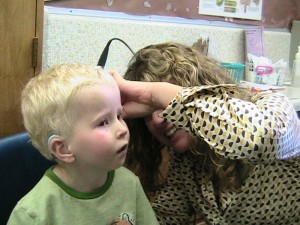
Then she pops the two kinds of goo out of their little bubble wrappers, and she mixes them together into a pliable substance that can be squeezed out of a syringe but will harden within a few minutes. Beanie, supervising, thought this mixing process looked pretty nifty and is now wondering how to work “become an audiologist” into her plan to be a scuba-diver with ten children.
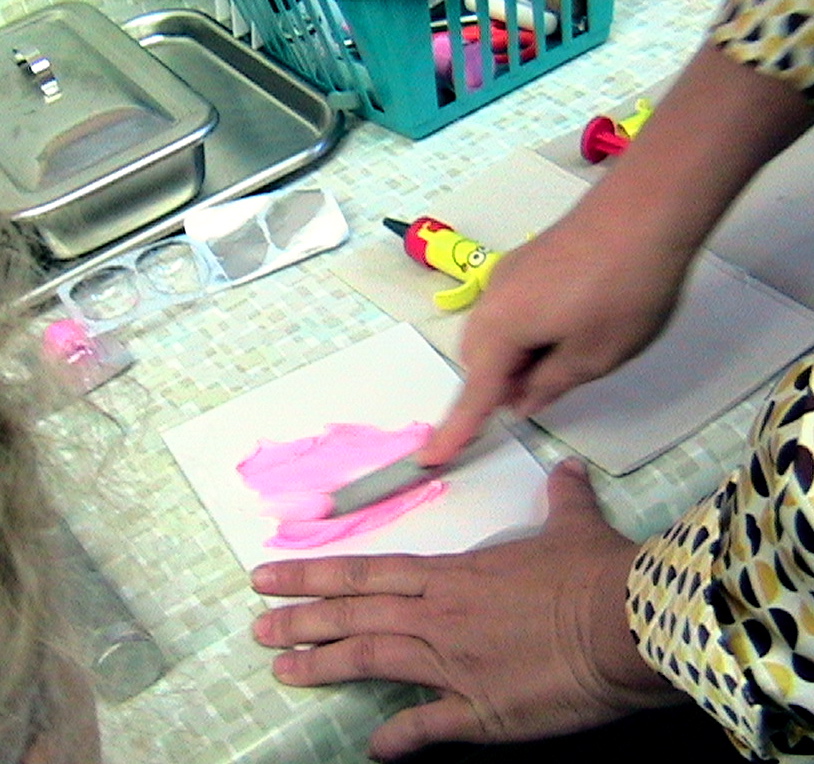
The audiologist scoops the goo into the syringe and carefully squeezes it into the ear, sort of like making an icing rose on a birthday cake. Now you have to sit and wait. You can’t poke at the goo, much as you might wish to. Nor can you pull on the string that is connected to the little foam stopper inside your ear canal. Patience, grasshopper.

Meanwhile, the audiologist squirts the leftover goo out of the syringe. This, I am told, is THE BEST PART.
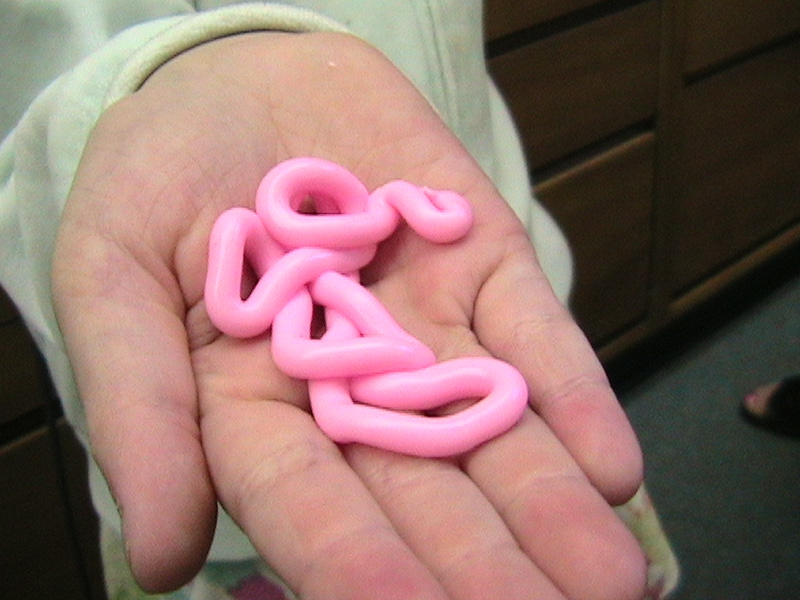
Let’s do the other ear while we’re waiting. It’s okay to drool.
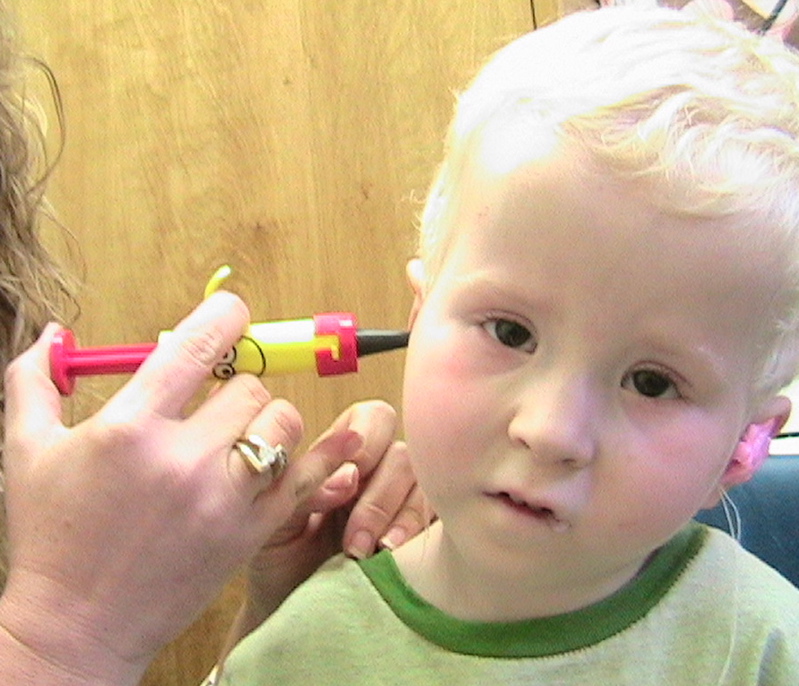
Finished! Time to pull out the impression. No need to be suspicious; it won’t bite.

The impressions go into a box and are dispatched to the Lab, that mysterious place where ear molds are born.
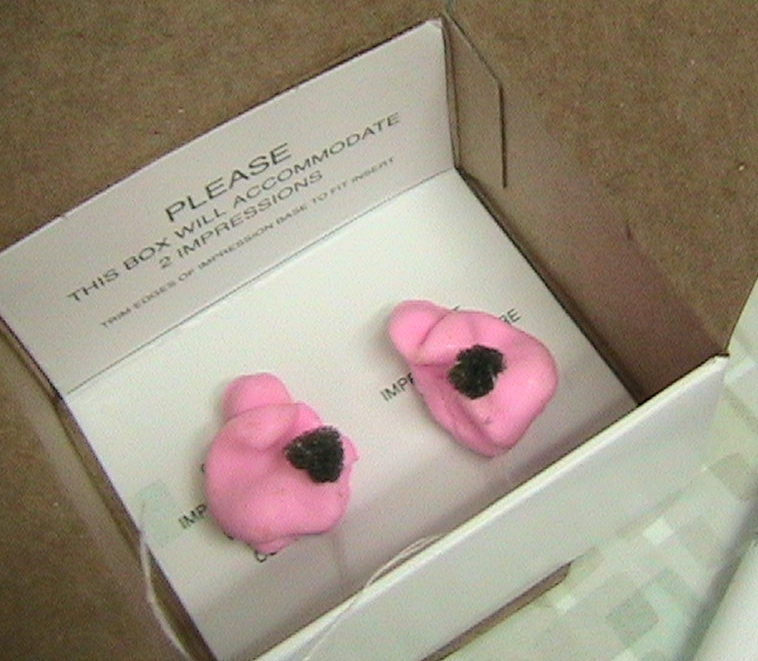
Now comes the fun part! (The other fun part, says Beanie.) What color ear molds do you want? The sky’s the limit. No, Bean, you can’t have a pair of sparkly ones for yourself.
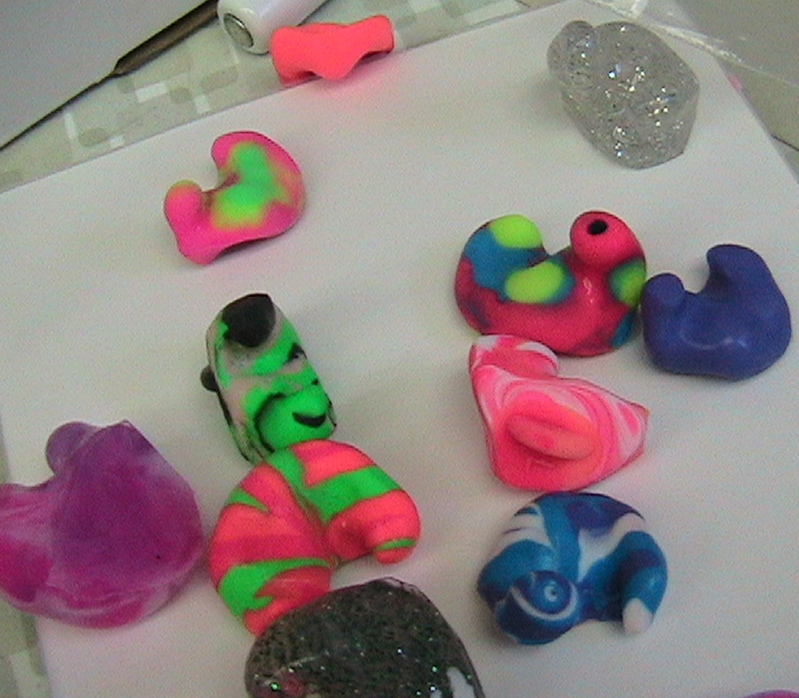
What color did he get? You’ll have to wait two weeks to find out.
Related post: The Deliciousness of Mah
Today was the Solemnity of the Assumption, a holy day for us. We went to the 9 a.m. Mass at the chapel of a local nursing home run by Carmelite sisters. The kids and I sat in the last row, but the boy grew too noisy, and I had to take the two little ones out to the lobby. By “too noisy” I mean he’s in this phase where his favorite favorite thing is to ruff-ruff like a puppy. There we were in this tiny little chapel full of nuns and elderly people, and my son was barking. During the homily. Embarrassing much? You could say that.
So I spent the rest of Mass in the lobby, my cheeks burning, trying to keep the barking to a whisper. Trouble is, Wonderboy can’t HEAR a whisper. This has a somewhat limiting effect upon his desire to vocalize sotto voce. I was kicking myself for not getting the crew up and out early enough to make the 8 a.m. Mass at our own parish, which has a soundproofed cry room.
When Mass was over, the priest, an elderly fellow himself, walked straight through the chapel doors to the lobby where I was standing. He smiled at us, shook my hand, admired the beautiful children. I apologized for Wonderboy’s noise.
The priest held a hand to his ear.
“Eh? What’s that?” he shouted, in the unmistakable tones of the hard-of-hearing.
It is impossible for me to convey the deliciousness of that moment. In an instant, my mortification was gone. Of course I still wished that Wonderboy had kept quiet (he’s been so good during Sunday Mass the last couple of months—and we sit right near the front of the church, not in the cry room, which is a rowdy, unpleasant place on a Sunday), but I realized once again what experience has taught me so many times. We’re never as great a nuisance as I think we are in situations like this. Hardly ever is anyone judging us as sternly as I am, behind my flaming cheeks.
“What’s that you said?” the priest repeated.
I raised my voice, as if I were talking to my semi-deaf son. “I’M SORRY MY LITTLE BOY WAS SO NOISY DURING MASS!”
The priest gave a hearty laugh. “It’s not like I would notice!”
He laid a hand on Wonderboy’s head, gnarled fingers patting the white-blond hair above the blue hearing aids.
“My brother had fourteen children,” he said. “Fourteen nieces and nephews, I had. Now those children could make some noise!”
The congregation began to file out: white-haired ladies with walkers, old men leaning on canes, beaming Carmelite sisters in their brown habits—every one of them stopping to smile at the children, ruffle a head of hair, shake a hand. There was no hint of reproof or censure in anyone’s manner: only warm smiles, friendly greetings, huge peals of laughter when Wonderboy, God bless him, ruff-ruffed at them. These good souls seemed universally delighted to see—and yes, even hear—youngsters in the aisles of their nursing home which, perhaps, come to think of it, is sometimes all too quiet.
Originally posted in June 2006.
Wonderboy’s hearing loss came as a shock to us. Sure, we knew he’d failed the newborn hearing test. Three times. But those rounds of testing were administered in the NICU where there is always a humming and beeping of background noise, and the tech had told us that ambient noise could skew the test results. We had more pressing things to worry about: his (minor) heart defect; his recovery from omphalocele repair surgery; the genetic testing necessary to determine whether he had a potentially serious chromosomal syndrome; the fact that he was going home on oxygen. At least he was going home, and we tucked the hearing-test business to the back of our minds and focused on the immediate business of keeping him alive.
Every month the health department sent us a letter reminding us to have the hearing screen repeated. Sure thing, we said, just as soon as things slow down a bit. We were constantly having to take him to some specialist or another. The chromosome study came back negative: his medical issues were not due to a genetic syndrome. He was just one of those babies for whom something goes slightly awry early on in utero, resulting in a number of physical abnormalities down the line. An MRI had shown brain abnormality, but what its effects would be, no one could say: time will tell, they said. (They are still saying that.) He had extremely high muscle tone (hypertonia) and could not stretch out his arms and legs very far. His fists were tightly clenched. He started physical therapy at four months of age. He required emergency surgery to repair a double hernia with incarcerated bowel. The cardiologist was still keeping a close eye on his heart. The hearing test would just have to wait.
Besides, we told ourselves, we know he isn’t deaf. He startled to loud noises. Of all the things there were to worry about, we really didn’t think hearing loss was one of them.
But by six months, we had suspicions. He wasn’t babbling. He didn’t turn his head at the sound of my voice, lighting up with recognition before even seeing me, as our other children had. We took him back for another hearing screen.
He failed.
The audiologist said something about a “mild” hearing loss, and I thought that didn’t sound too bad. “Oh, no,” she told me, hastening to set me straight. “It isn’t like a ‘mild’ fever. ANY hearing loss is serious. Most speech sounds fall at the bottom of the scale, so if you have any hearing loss at all, you’re going to have trouble with speech.”

As it turned out, Wonderboy’s loss was a bit more serious than the audiologist first thought. Further testing placed him at the “moderate” level on the scale of mild—moderate—severe—profound. Unaided, Wonderboy’s ears can’t detect sounds softer than 50 decibels. Most speech sounds fall in the 20-decibel-or-lower range. Our little guy can hear vowel sounds, the louder middles of words, but few of the consonants that shape sound into speech. For Wonderboy, people probably sound a lot like Charlie Brown’s teacher. Wah-WAH-wah-wah-waahh-wah. We learned about the speech banana: the area on a graph that shows where speech sounds fall in the decibel and frequency ranges. Wonderboy can’t hear sounds above the horizontal 50 line on that chart.
(More or less. He has a sloping loss which is slightly better at the lower frequencies.)
By his first birthday he was wearing hearing aids, and what a huge difference we could see! Aided, he tests around the 20-decibel range. He hears and understands a great deal of what we say. He is two and a half years old now, and he is finally beginning to add some consonant sounds to his verbal speech. Daddy used to be “Ah-ee” and now he is “Gaggy.” (This cracks me up. You can get a lot of mileage out of calling your husband Gag.) Grandpa is Amp-Ha. Wonderboy’s baby sister is “Gay-gee.” As you can see, he doesn’t have a B sound yet. His M is perfect, though; I have been Mommy, clear as a bell, for over a year.
 But Wonderboy’s verbal speech is only part of the picture. His actual vocabulary is enormous, thanks to sign language. We are huge fans of the Signing Time DVDs. He uses a combination of sign and speech; we all do. Although it appears he will be primarily a verbal person as he gets older, sign language will always be an important second language for him. Hearing aids, incredible as the technology is nowadays, don’t do you any good at the swimming pool. Just for instance.
But Wonderboy’s verbal speech is only part of the picture. His actual vocabulary is enormous, thanks to sign language. We are huge fans of the Signing Time DVDs. He uses a combination of sign and speech; we all do. Although it appears he will be primarily a verbal person as he gets older, sign language will always be an important second language for him. Hearing aids, incredible as the technology is nowadays, don’t do you any good at the swimming pool. Just for instance.
Hard of hearing. It used to be a phrase that conjured up in my mind the image of a grizzled old man with an ear trumpet. What? What’d ye say? Speak up, lad! (Apparently he is a grizzled old Scotsman.) Now it applies to my son. Words pop up on a TV screen, “closed captioned for the deaf and hard of hearing,” and I’ll give a little mental jump: Oh! That means Wonderboy!
Watching our children learn to speak is one of the great delights of parenthood. We mothers tend to collect their funny pronunciations, their experimentation with the meanings of words. This time around, my joy has been doubled, for I get to see communication unfold in two languages. His funny little toddler signs are just as endearing as any “helidopter” or “oapymeal” ever uttered by a two-year-old. (“Oapymeal” was one of Jane’s. It meant oatmeal. I served it often just to hear her say it.)
There are some links to American Sign Language resources in the sidebar of my old site. (I’ll set up a page here soon as I get a chance.) I can’t say enough about the wonders and benefits of ASL, not just for deaf and hard of hearing children, but for all babies and toddlers, especially those with any type of speech delay. ASL is a beautiful, nuanced language, a visual poetry. I count myself privileged to have been put in the way of learning it. Jane is determined to certify as an interpreter someday, and I have to admit I’m a little jealous. I wish I’d learned at her age.
Wonderboy makes a fist and touches a knuckle to his cheek, wiggling the hand. “Ah-hul!” he shouts. Apple, in two languages. The speech banana? We’ll get there, one way or another.
*Audiogram image courtesy of GoHear.org.
Tags: special needs children, American Sign Language, baby sign language, hard of hearing
When I mentioned yesterday how many specialists my son sees at the children’s hospital, commenter Anna marveled,
Melissa, ELEVEN specialists? Next time I grouse about two specialists, I’ll shut up. 😉
Oh no, please don’t shut up. Grouse along with me! Medical appointments expand to fill the space around them, don’t they, so that I’m guessing your two specialists suck up massive amounts of time just like our eleven.
Eleven is only the number of departments Wonderboy visits at the Children’s Hospital. Then there’s his pediatric ophthamologist at the university hospital, and the speech therapist and audiologist in the school district. Oh, and also the regular pediatrician, his primary care doctor. If you add in his dentist, and since the child managed to knock out four of his teeth in the past year, I think we may certainly add the pediatric dentist to the roster, that’s (gulp) 16 doctors and therapists my little guy sees on a regular or semi-regular basis.
Yes, it’s a little nuts.
One of the hardest parts of juggling this caseload is keeping all these folks on the same page: namely, the page that is all about the whole picture of this kid, not the tiny piece Dr. Specialist is focusing on. I often compare my role as having to hold tight to the leashes of a bunch of big dogs all pulling in opposite directions. And sometimes it seems like the doctors communicate with each other about as well as dogs do.
In Virginia, we had some personal connections with a few doctors in a way that meant I had another set of hands helping me hold on to the leashes. You may remember how I pined for our Dr. Lily when we left, wished I could bring her with me. (She actually did offer to fly out to California with me and the children when she heard I was going to drive them out here all by myself. Now that’s dedication. But I was more afraid of five hours on an airplane with Wonderboy than two weeks in the minivan, even sans other adults.)
Here in San Diego, we have excellent doctors, absolutely. But none who have taken that step past the detached professional relationship toward a more familiar, I’m-your-ally-let-me- help-you-with-those-Huskies rapport. I’ve had to come up with some strategies for making sure all the boy’s doctors take the time to at least glimpse at the whole picture of him, not just their individual pieces of the puzzle.
The biggest help has been the Doctor Roster. I typed up a list of all the people Wonderboy sees. Four columns. First column: doctor’s name and phone number. Second column: doctor’s specialty or department. Third column: date of most recent appointment. Fourth column: Notes on the last appt, tests ordered, recommendations made, etc.
I’m saying doctor, but this also includes his PT, speech therapist, etc. Everyone involved in his treatment.
I carry several of these lists with me to every appointment. It’s the first thing I hand a doctor when he or she walks into the room. Always, the eyebrows go up: the complexity of the big picture is immediately apparent from the length of the list.
I’ve begun to notice some major improvements in communication between departments since I began handing out this list, and I have definitely found that the individual specialists spend more time asking me questions about his history and his overall treatment plan.
Of course, if only the kid had one global diagnosis, that would help so much! One peg for the docs to hang their hats on; one road map to follow. But that, we know by now, isn’t likely to happen. There is no syndrome that fits, no other case in history that contains this specific bizarre amalgam of issues. Someday, some savvy doctor is going to write a paper on the kid and there’ll maybe be a new syndrome in the books. It’ll be named after the doc, but we’ll know it’s Wonderboy Syndrome, won’t we?
February 12, 2008 @ 6:11 pm | Filed under:
Wonderboy "Watch me, Mom," says my son, a hundred times a day or more. This isn’t the typical four-year-old’s "Look what I can do!"—what he means is Look at me because I want to tell you something. He doesn’t grasp that I am not hard of hearing; I don’t need to watch his lips move to be sure of what he is saying. He needs to see my face to "hear" me best, and naturally he assumes the reciprocal is true.
If I don’t turn quickly enough, he takes hold of my chin with one firm little hand, turning my face toward his. Yanking it, sometimes. Wookit me, Mom.
He is cuter than ever to wookit these days, thanks to the spiffy new glasses he is sporting.

Sometimes I spike up his hair so he looks like the kid from Jerry Maguire. This makes me laugh. I glance at him in my rear-view mirror and expect him to ask me if I know the human head weighs eight pounds.
When I went to put the glasses on him the first morning, he wasn’t at all sure he was on board with this plan. Then Scott put on his glasses—I wear contacts, so Scott is the only bespectacled member of the household—and the boy was all of a sudden thrilled to don his own specs. You didn’t tell me it was a MAN thing, Mom! Bring ’em on!
From that moment on it has been smooth sailing, though there are certain logistics he has yet to figure out, such as what to do with one’s man-glasses while one is observing the time-honored man custom of sacking out on the couch on a Sunday afternoon.


Oh, and here’s one last look at the Lilting House photo album. I think that site goes down tomorrow. I reeeealllly need to finish updating my links, argh!
Still trying to tidy up my archives. Here are the most substantive posts I’ve written about Wonderboy’s hearing loss:
The Speech Banana (hearing loss diagnosis)
Getting Ear Molds Made (a photoessay)
Practicing for Hearing Tests (games to help preschoolers in the sound booth)
Speech Therapy at Home
Visual Phonics
Newborn Hearing Test Advice
Sign Language (how awesome it is)
Learning ASL as a Family
Fun with FM (heh heh)
Expressive and Receptive Language
This Lilting House post gets more search-engine hits than anything else I’ve written. Every week I am amazed by how many people land on my blog via a search for “speech banana” and related terms. I thought it might be helpful if I reposted it here. This post was written in June of 2006. More recent posts on related subjects can be found in the hearing loss archive, including a photo essay about getting ear molds for hearing aids and advice regarding the newborn hearing screen.
Wonderboy’s hearing loss came as a shock to us. Sure, we knew he’d failed the newborn hearing test. Three times. But those rounds of testing were administered in the NICU where there is always a humming and beeping of background noise, and the tech had told us that ambient noise could skew the test results. We had more pressing things to worry about: his (minor) heart defect; his recovery from omphalocele repair surgery; the genetic testing necessary to determine whether he had a potentially serious chromosomal syndrome; the fact that he was going home on oxygen. At least he was going home, and we tucked the hearing-test business to the back of our minds and focused on the immediate business of keeping him alive.
Every month the health department sent us a letter reminding us to have the hearing screen repeated. Sure thing, we said, just as soon as things slow down a bit. We were constantly having to take him to some specialist or another. The chromosome study came back negative: his medical issues were not due to a genetic syndrome. He was just one of those babies for whom something goes slightly awry early on in utero, resulting in a number of physical abnormalities down the line. An MRI had shown brain abnormality, but what its effects would be, no one could say: time will tell, they said. (They are still saying that.) He had extremely high muscle tone (hypertonia) and could not stretch out his arms and legs very far. His fists were tightly clenched. He started physical therapy at four months of age. He required emergency surgery to repair a double hernia with incarcerated bowel. The cardiologist was still keeping a close eye on his heart. The hearing test would just have to wait.
Besides, we told ourselves, we know he isn’t deaf. He startled to loud noises. Of all the things there were to worry about, we really didn’t think hearing loss was one of them.
But by six months, we had suspicions. He wasn’t babbling. He didn’t turn his head at the sound of my voice, lighting up with recognition before even seeing me, as our other children had. We took him back for another hearing screen.
He failed.
The audiologist said something about a “mild” hearing loss, and I thought that didn’t sound too bad. “Oh, no,” she told me, hastening to set me straight. “It isn’t like a ‘mild’ fever. ANY hearing loss is serious. Most speech sounds fall at the bottom of the scale, so if you have any hearing loss at all, you’re going to have trouble with speech.”

As it turned out, Wonderboy’s loss was a bit more serious than the audiologist first thought. Further testing placed him at the “moderate” level on the scale of mild—moderate—severe—profound. Unaided, Wonderboy’s ears can’t detect sounds softer than 50 decibels. Most speech sounds fall in the 20-decibel-or-lower range. Our little guy can hear vowel sounds, the louder middles of words, but few of the consonants that shape sound into speech. For Wonderboy, people probably sound a lot like Charlie Brown’s teacher. Wah-WAH-wah-wah-waahh-wah. We learned about the speech banana: the area on a graph that shows where speech sounds fall in the decibel and frequency ranges. Wonderboy can’t hear sounds above the horizontal 50 line on that chart.
(More or less. He has a sloping loss which is slightly better at the lower frequencies.)
By his first birthday he was wearing hearing aids, and what a huge difference we could see! Aided, he tests around the 20-decibel range. He hears and understands a great deal of what we say. He is two and a half years old now, and he is finally beginning to add some consonant sounds to his verbal speech. Daddy used to be “Ah-ee” and now he is “Gaggy.” (This cracks me up. You can get a lot of mileage out of calling your husband Gag.) Grandpa is Amp-Ha. Wonderboy’s baby sister is “Gay-gee.” As you can see, he doesn’t have a B sound yet. His M is perfect, though; I have been Mommy, clear as a bell, for over a year.
 But Wonderboy’s verbal speech is only part of the picture. His actual vocabulary is enormous, thanks to sign language. He uses a combination of sign and speech; we all do. Although it appears he will be primarily a verbal person as he gets older, sign language will always be an important second language for him. Hearing aids, incredible as the technology is nowadays, don’t do you any good at the swimming pool. Just for instance.
But Wonderboy’s verbal speech is only part of the picture. His actual vocabulary is enormous, thanks to sign language. He uses a combination of sign and speech; we all do. Although it appears he will be primarily a verbal person as he gets older, sign language will always be an important second language for him. Hearing aids, incredible as the technology is nowadays, don’t do you any good at the swimming pool. Just for instance.
Hard of hearing. It used to be a phrase that conjured up in my mind the image of a grizzled old man with an ear trumpet. What? What’d ye say? Speak up, lad! (Apparently he is a grizzled old Scotsman.) Now it applies to my son. Words pop up on a TV screen, “closed captioned for the deaf and hard of hearing,” and I’ll give a little mental jump: Oh! That means Wonderboy!
Watching our children learn to speak is one of the great delights of parenthood. We mothers tend to collect their funny pronunciations, their experimentation with the meanings of words. This time around, my joy has been doubled, for I get to see communication unfold in two languages. His funny little toddler signs are just as endearing as any “helidopter” or “oapymeal” ever uttered by a two-year-old. (“Oapymeal” was one of Jane’s. It meant oatmeal. I served it often just to hear her say it.)
I put some links in my sidebar for American Sign Language resources. I can’t say enough about the wonders and benefits of ASL, not just for deaf and hard of hearing children, but for all babies and toddlers, especially those with any type of speech delay. ASL is a beautiful, nuanced language, a visual poetry. I count myself privileged to have been put in the way of learning it. Jane is determined to certify as an interpreter someday, and I have to admit I’m a little jealous. I wish I’d learned at her age.
Wonderboy makes a fist and touches a knuckle to his cheek, wiggling the hand. “Ah-hul!” he shouts. Apple, in two languages. The speech banana? We’ll get there, one way or another.
*Audiogram image courtesy of GoHear.org.
Related posts:
• Signing Time DVDs
• More about Signing Time
• Rilla Signs
• Unsolicited Signing Time Commercial
• Signing with Babies, My Favorite Topic
As I’ve mentioned before, mommyspeechtherapy.com is a good source of tips for how to work on specific speech sounds with your children.
As I work (and play) with Wonderboy, I’ve come up with a few games of my own that are helping him practice the new sounds he is learning to produce. One particularly sweet one is how we practice the p sound, which is still relatively new for him. I thought it might help if he could feel it, feel how the air explodes from one’s lips during the puh sound. I touch my lips to his cheek, like a kiss, and say words like piano, pizza, apple, emphasizing the p. He has begun to reciprocate, pressing his little face to my cheek and puhracticing his puhlosives. It’s so cute, I want to eat him up, like pizza or an apple.
We also use the Visual Phonics signs to help make consonant sounds pop for him. Since sign is Wonderboy’s other language, having signs connected with sounds makes a lot of sense to him. If I make the visual phonics sign for the first sound in a word, and then follow with the whole word, both in English and ASL, he gets that the sound itself is something that can be broken out of the word and made on its own. So: buh, buh, baby. The "buh" is the Visual Phonics sign for the sound made by the letter b: you hold the ASL sign for b up to your mouth, and as you say "buh," you move the b sign rapidly away. That’s the phoneme sign.
We do this over and over, all through the day. Guh guh go, kuh kuh car, puh puh pizza. (Yes, more pizza. If you spend much time at my house, you know that we are all about the pizza here. I don’t cook for people. I invite them over for pizza. Can’t make it? Eh, we’ll order that pizza anyway.)
We’re working on developing his listening differentiation skills with a game we play with Rilla. Wonderboy thinks he is teaching things to Rilla (and he is), and this makes it loads of fun for him. He doesn’t realize he’s making big leaps himself.
We have a stack of pictures of objects with sounds we’re working on. Right now it’s the f sound, so we have fish, frog, fire, phone, etc. I lay out two or three of the cards and give Wonderboy or Rilla a block to hold. Then I’ll say the name of one of the items on the cards, and the child whose turn it is puts the block on the right card. It’s a very simple game and both the little ones eat it up.
For Wonderboy, what the game is doing is helping him hear the subtle differences between similar-sounding English words. With his hearing aids, he can hear a good deal of speech, but not everything—not some of the soft, unvoiced consonant sounds. So I lay out pictures of phone and bone, or fish and dish, and the game—which is great fun, especially because of the antics of little miss Rilla—hones his listening skills.
I think he is doing a lot of lip-reading. He’s a crackerjack at the game when he can see my mouth, and has more difficulty if I hide my lips behind a hand. When he sits beside me and chatters away, as is happening almost constantly these days, he cups my chin with one determined little hand, turning my face toward his. This is indescribably sweet, I have to say. At a birthday party a couple of weeks ago, a friend’s mother was watching Wonderboy talk to me, and she said, "That is so dear! The way he studies your face! He can’t take his eyes off you."
It is dear. It’s a good idea, though, to help hone his listening skills without visual clues when we can. So we play another game, also with Rilla, in which each child hold a little ball up to his or her ear, and I cover my mouth and make a sound. The game is simple: when the child hears the sound, he or she drops the ball into a container. We use an empty tennis ball canister. The main purpose of this game is to get Wonderboy into the groove of what happens in a hearing test when we go to the audiologist. In order to accurately test his hearing (and therefore ensure that his hearing aids are calibrated correctly, in the way that will give him the best possible amplification), we need him to respond to each sound he hears. The ball-in-canister game is one we can easily duplicate in the sound booth.
It’s also great fun. Rilla thinks it’s a hoot! Her excitement is infectious, and Wonderboy and I are usually in giggles the whole time. They hold the balls up to their ears just to reinforce that they are going to listen. Wonderboy thinks Rilla jumps the gun a lot; he doesn’t realize that she is hearing sounds that don’t exist for him. He doesn’t seem to hear S or SH at all.















